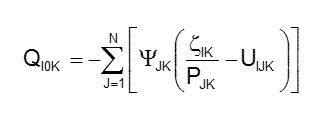SFEcon portrays economic adjustment as a process of sectors IK adjusting asset
levels (AIJK+BIJK
+CIJK) so that their employments EIJK
=VJ•(AIJK+BIJK+CIJK) of inputs
J tend toward optimizing their operations. This process is guided by the sectors’ continuous
re-evaluation in terms of their levels of absolute value (AI0K+BI0K+CI0K). Valuation
is subject to the requirement that sectors’ turnover of value EI0K=V0•(AI0K+BI0K+CI0K) will
settle at the sum of products of commodity values YJ G/unit with
physical asset turnovers EIJK units/year:

And the model’s integrity requires that all of the value flowing at an emulation’s inception Y00 must be kept coursing through the EI0K’s in their ‘proper’ proportions.
The apportionment of value proceeds via the same circuit of physical flows established among Model 0’s physical rates and levels. Here we see replenishment rates RIJK driving the circuit by which goods are produced and taken into inventories to more or less replenish that which is extinguished by production. RIJK was then defined in reference to the current optimal rate QIJK for IK to use J:
 Eqa. 12-2
Eqa. 12-2
Control of physical adjustments was accomplished by setting RIJK equal to QIJK whenever the availability of J is sufficient to do so, and rationing the availability of J according to the proportions of QIJK when J is insufficient.
To be operative from the standpoint evaluating the sectors IK, QI0K should receive a negative sum on the value equivalents of the demands QIJK being expressed in IK’s row:

This is accomplished by redefining Equation 12-2 for the special case of J=0:

The number of zIK’s in row IK is given by NIK; YJ/PJK has been replaced by 1/P0K in every term of the sum; and UI0K is defined as a sum on the values of IK’s utility parameters:

This equation has commodity values YJ entering the theoretical scheme through the evaluation of UI0K.
Column zero of our asset replenishment model will then be completed by having the RI0K’s distribute the entire, invariant supply rate of value units Y00 among the sectors IK in proportion to their QI0K’s. (It should be emphasized that full allocation of good 0’s supply Y00 is what keeps the quantity of GCU’s constant; and that this occurs in exception to the practice for all other all other goods, which are left on the market if supply exceeds demand.)
With RI0K’s known, the reference commodity of value moves through Model 0’s circuit of physical flows in the manner of any physical commodity. The level of value held by a sector IK, i.e.: AI0K+BI0K +CI0K, will be known in just the same fashion as is the level of any physical asset. And the variable EI0K=V0•(AI0K+BI0K+CI0K) will continuously re-evaluate the sectors IK in analogy to capitalism’s incessant re-casting of equity values.
With the quanta of value units GCU established for each sector IK, we are poised to compute commodity values YJ. When the more elusive P0K’s are also established, QI0K’s will be known and the problem of evaluating economic sectors in terms of a constant-value financial unit will have a theoretical solution.